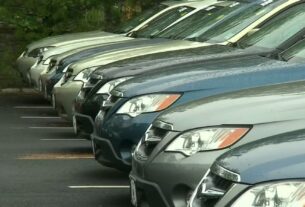Buying a car is a far more popular choice than leasing — in the second quarter of 2023, only 21% of all new vehicles were leased, according to Experian. But that doesn’t mean buying is the best option for everyone.
When it comes to overall cost, buying a car is the cheaper way to go. But for some car shoppers, saving money down the line isn’t the main goal. If you’re more concerned with reducing your upfront costs or lowering your maintenance expenses, or if you just prefer driving new cars with state-of-the-art technology, leasing might meet your driving needs.
You are watching: Should I lease or buy a car?
Leasing a car
Best for: Drivers who want a new vehicle every few years
Leasing may be right if you don’t want a long-term commitment. Like renting a car, a lease gives you access to a vehicle you don’t own, typically for three to four years.
“It’s a better option when the buyer prefers driving a newer vehicle every few years and wants to access the latest safety and technology,” said Jeff Turley, president of auto lending at PNC Bank.
There are restrictions to leasing, however. You’re subject to an annual mileage cap and specific maintenance requirements, and you won’t own the car when the lease is through.
Pros and cons of leasing a car
In terms of upfront costs and monthly payments, leasing is often much cheaper than buying. The average monthly lease payment on a new car in the second quarter of 2023 was $586, while the average loan payment was $729, according to Experian.
But along with the lease comes various fees and restrictions that can be difficult for lessees to understand and track. For example, you must carry comprehensive insurance coverage and maintain the car according to the manufacturer’s servicing requirements. Also, your lease will come with a mileage cap, commonly 12,000 or 15,000 miles per year, and if you exceed your mileage limit, you can expect to pay hefty overage fees.
Unlike buying, you won’t own the car at the lease’s end and can’t sell or trade it in. Instead, when the lease is up, you can return the car to the dealer and pay the lease-end charges or you can buy the car outright.
The biggest drawback is that the money spent doesn’t lead to ownership. “Leasing often has lower monthly payments, but at the end of the lease term, there’s no equity or asset,” said Turley. “This can lead to a cycle of continuous monthly payments.”
Buying a car
Best for: Drivers who prioritize long-term savings
When you use a loan to buy a car, you make regular monthly payments over a set repayment term. When the payments are complete, you’ll own the vehicle outright. That means you’ll eventually be free of monthly vehicle payments, and you can sell or trade in the vehicle at any time.
But cars are more expensive than ever — the average new car was more than $48,000 in 2023, according to Kelley Blue Book (KBB). This price tag may put ownership out of reach for some drivers. This is especially true when considering that you’ll likely need to make a 20% down payment to secure financing.
If you want to truly maximize your savings, consider saving up and buying a car with cash, rather than financing the purchase. Even if you qualify for a lender’s lowest rate, you’ll pay thousands of dollars in interest over the life of your loan. Paying cash for a car can be a smart financial move as long as it doesn’t deplete your emergency savings.
Pros and cons of buying a car
You may find it more difficult to be approved for a car loan than a lease. The down payment and credit score requirements are often higher for loans than for leasing, and the monthly payments can be higher too.
See more : Edmunds.com recognizes ‘Best Retained Value’
On top of that, some car loans take as long as seven years to pay off. You can opt for a shorter repayment term, which will reduce your overall interest charges but can result in higher monthly payments.
Despite the drawbacks, buying is the better option for saving money. Unlike with leasing, financing a car eventually leads to ownership with no more monthly payments.
10 factors to consider when deciding between leasing and buying
Buying and leasing each impact your wallet — and your level of satisfaction with your car — in different ways. Before choosing one option over the other, consider the following factors:
1. Monthly payments
Auto loan terms typically range from two to seven years, while lease agreements usually last two to four years.
In addition to longer repayment terms, you could pay several hundred dollars more each month to buy a car than to lease it. Consider the monthly savings on the following popular leased models:
Average monthly payment on new auto loans versus leases, 2023
While the monthly payments are cheaper on leases, they can still be high. According to Statista, the average monthly lease payment in 2023 ranged from $563 to $621, depending on the lessee’s credit scores.
2. Overall cost
Buying a car may seem more expensive than leasing, but in the long run, it’s the other way around.
“Buying a car typically involves a higher upfront cost, but over time, the owner builds equity in the vehicle and can potentially recoup some of those costs when reselling,” said Turley.
While leasing may get you into a car with no down payment, you can make lease payments for unlimited years without ever owning a car. But if you buy and keep a car, especially one that’s pre-owned (meaning it’s seen the majority of its depreciation already), you can save far more money overall.
3. Down payment
Many lenders require you to pay up to 20% of the purchase price as a down payment. For the average new car, which cost $48,334 in July 2023 according to KBB, a 20% down payment would be $9,667.
While you might want to make a smaller down payment when you buy a car, the more you pay upfront, the more you save on interest charges and monthly payments.
In contrast, you can’t reduce your lease payments by making a down payment on your lease, and a down payment may not even be required. You might, however, have to make a security deposit roughly equal to one month’s lease payment. The dealer may also allow you to make two deposits in return for a lower “money factor,” or interest rate.
4. Depreciation
When you lease a car, most of the monthly lease payment covers the cost of the car’s depreciation.
But when you own a car, depreciation means losing value in your asset. Data shows that new cars lose an average of 20% of their value in their first year. If the car depreciates quickly, you could even owe more on your loan than the car is worth, particularly if you don’t make a large down payment.
5. Car insurance
See more : BMW i4 Trim Levels: A Comprehensive Comparison
Dealers typically require lessees to carry collision and comprehensive coverage in addition to state-mandated insurance, according to the Insurance Information Institute. You’ll likely also have GAP insurance rolled into your monthly lease payment.
While lenders may also require you to carry certain coverage when you finance a car, you can adjust the coverage once you pay off the loan.
6. Repairs
Both car buyers and car lessees have to worry about repairs — but the out-of-pocket cost is likely to be lower for lessees. This is because lessees are perpetually driving new vehicles, which tend to come with robust manufacturer’s warranties. Once the warranty runs out, a car owner will have to foot the bill to fix their vehicle.
At the same time, you’ll have to follow certain servicing recommendations from the manufacturer while on a lease, and the warranty won’t cover basic maintenance like replacing tires and changing the oil. If you don’t keep the car in great shape, you can be charged fees for excessive wear and tear. As an owner, however, you’re free to maintain your vehicle as you choose.
7. Leasing fees
When you take out an auto loan, you may have to pay an origination fee to the lender, and dealers can also add charges to financing. With a lease, you may have to pay thousands of dollars to cover some or all of the following fees upfront, throughout your lease or at its end:
- Acquisition or administrative
- Dealer documentation
- Destination and handling
- Monthly rental
- Disposition or turn-in
- Early termination
8. Mileage
Lease agreements limit the number of miles you’re permitted to drive each year, usually 12,000 or 15,000. You may be charged for excessive mileage if you exceed the cap outlined in your lease agreement. If you know in advance that you’re likely to drive more miles than allowed, some lessors allow you to buy additional miles, which can cost anywhere from $0.10 to $0.30 per mile.
Buying a car may be the most cost-effective option if you regularly rack up miles on your odometer. Remember that the more miles you put on your car, the lower its resale value will be.
9. Modifications
When you own a vehicle, you can make any (legal) changes you want, like adding custom wheels, upgrading the sound system or adding other third-party accessories. When you lease, however, the car doesn’t belong to you, so you can’t make permanent modifications.
10. New technology
For some drivers, that new car smell is the most important consideration when shopping for a vehicle. Leasing allows you to drive a new car with updated technology every few years, so it’s the better option for someone who values having the most up-to-date safety features or entertainment technology.
Buying vs. leasing: Making a final decision
Leasing a car is more expensive overall than buying, but it’s still the best option for some drivers. When asking yourself, “Should I lease or buy a car?” the following scenarios may help you decide:
Ultimately, examine your budget and understand your goals before committing to a new lease or loan agreement. Use a lease versus buy calculator (like this one from Edmunds) to help you decide which option is right for you.
Frequently asked questions (FAQs)
At the end of your car lease, you can either turn the car in or buy the car. The purchase price will be based on the car’s value at the time of lease-end. Review your lease agreement to fully understand your options.
If your credit scores are low or you have limited funds for a down payment, you may find it easier to get approved for a lease than for an auto loan.
Yes, you can negotiate certain terms of your lease. The terms you may be able to negotiate include:
- Vehicle cost
- Down payment amount
- Mileage limit
- Lease-end purchase option
Having bad credit makes it difficult to buy or lease a car, but it can be easier to get a lease with low scores. Remember that your lease payments and fees will likely be higher if your scores need work.
Source: https://us.congthucvatly.com
Category: Car



